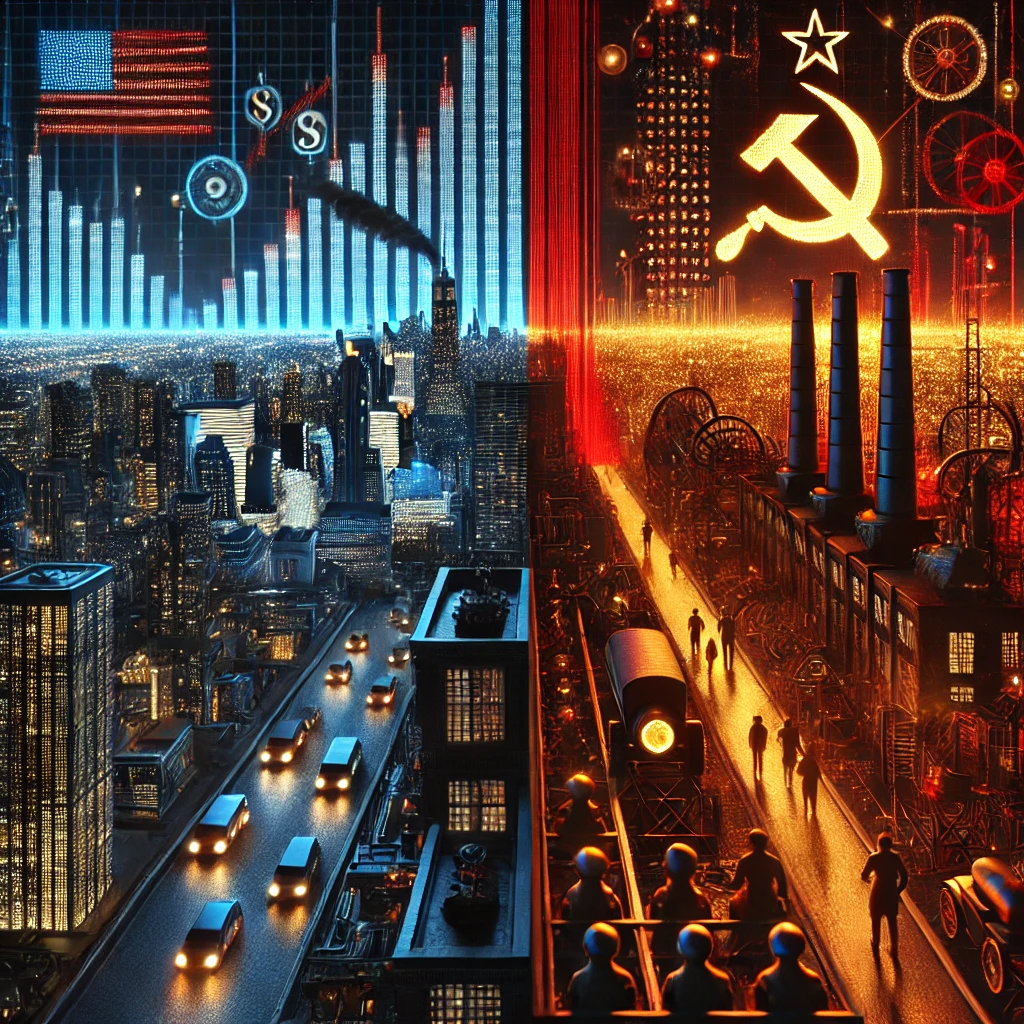Introduction
The 1920s was a decade of significant economic development for both the United States and the Soviet Union, albeit with vastly different approaches. While the U.S. embraced capitalism and free-market policies, the Soviet Union pursued a centrally planned economy under communist ideology. These divergent economic policies shaped the trajectory of both nations and had lasting impacts on global economic and political history. This article provides an in-depth comparison of their economic strategies, key policies, and outcomes.
Economic Policies of the United States in the 1920s
1. The Rise of Consumer Capitalism
The United States experienced a period of rapid economic growth in the 1920s, often referred to as the “Roaring Twenties.” This growth was driven by mass production, technological advancements, and a booming consumer culture. The rise of assembly-line production, pioneered by Henry Ford, led to an increase in the availability and affordability of consumer goods such as automobiles, radios, and household appliances.
2. Laissez-Faire Policies
The U.S. government, under Presidents Warren G. Harding, Calvin Coolidge, and Herbert Hoover, pursued a laissez-faire approach, minimizing government intervention in the economy. Some key policies included:
- Tax Cuts: The government reduced income taxes, particularly for the wealthy, under the Revenue Acts of 1921, 1924, and 1926.
- Deregulation: The administration encouraged business expansion with minimal oversight, believing that a free-market approach would lead to prosperity.
- High Tariffs: The Fordney-McCumber Tariff of 1922 imposed high tariffs on imported goods, protecting American industries but reducing international trade.
3. Stock Market Speculation and Credit Boom
The 1920s saw a surge in stock market investments, with many individuals buying stocks on margin (borrowed money). Easy credit policies and consumer installment plans fueled economic expansion but also created an unstable financial environment, ultimately leading to the stock market crash of 1929.
4. Industrial Growth and Urbanization
Economic policies favored industrial expansion, resulting in increased urbanization and job opportunities. However, wealth inequality grew, with rural farmers and lower-income groups struggling despite the overall prosperity.
Economic Policies of the Soviet Union in the 1920s
1. War Communism (1918-1921)
Before transitioning to new economic policies in the 1920s, the Soviet Union had followed “War Communism” during the Russian Civil War. This policy involved:
- Nationalization of industries and banks
- Forced grain requisitioning from peasants
- State-controlled distribution of goods
War Communism led to economic collapse, severe food shortages, and peasant resistance, prompting the Soviet government to shift to a more flexible economic strategy.
2. The New Economic Policy (NEP) (1921-1928)
Implemented by Vladimir Lenin, the NEP marked a temporary retreat from strict communist policies and allowed for limited market mechanisms to revive the Soviet economy. Key features of the NEP included:
- Private Enterprise: Small businesses and farms were allowed to operate privately while major industries remained state-controlled.
- Agricultural Reforms: Peasants could sell surplus grain in open markets, incentivizing production and reducing food shortages.
- Foreign Trade and Investment: The Soviet Union encouraged foreign investment in certain sectors to modernize the economy.
The NEP led to an economic recovery, stabilizing food production and improving living standards. However, some communist leaders, including Joseph Stalin, viewed it as a compromise with capitalism.
3. The Shift Toward Centralized Planning
By the late 1920s, Stalin began consolidating power and preparing to replace the NEP with a more centralized economic model. The move toward collectivization and state planning laid the groundwork for the Soviet Union’s industrialization drive in the 1930s.
Comparison of Economic Outcomes
| Aspect | United States | Soviet Union |
|---|---|---|
| Economic Growth | Rapid industrial expansion, high consumer spending | Slow recovery, but stable agricultural and industrial output under NEP |
| Government Role | Minimal intervention (laissez-faire) | Strong state control over key industries |
| Agricultural Policy | Market-driven, but suffered from overproduction and price drops | Partial privatization under NEP, later moved towards collectivization |
| Industrial Policy | Private sector-led growth, rise of major corporations | Mixed economy under NEP, later shifting to full central planning |
| Financial Stability | Stock market boom but led to the 1929 crash | Limited financial markets, state-controlled banking system |
| Social Impact | Rising wealth disparity, urban growth, consumer culture | Reduced inequality under NEP but limited personal freedoms |
Legacy and Impact on Future Economic Policies
The economic policies of the 1920s in both countries had long-term consequences:
- The United States’ economic boom ended with the Great Depression, highlighting the risks of unregulated markets and speculative investments.
- The Soviet Union’s NEP demonstrated that limited market reforms could revitalize an economy but was ultimately abandoned in favor of full central planning under Stalin.
Conclusion
The economic strategies of the United States and the Soviet Union in the 1920s reflected their ideological differences—capitalism vs. communism. The U.S. experienced rapid growth but faced instability, while the Soviet Union recovered from economic collapse through a mixed approach. The lessons from both models continue to influence economic policymaking worldwide.




